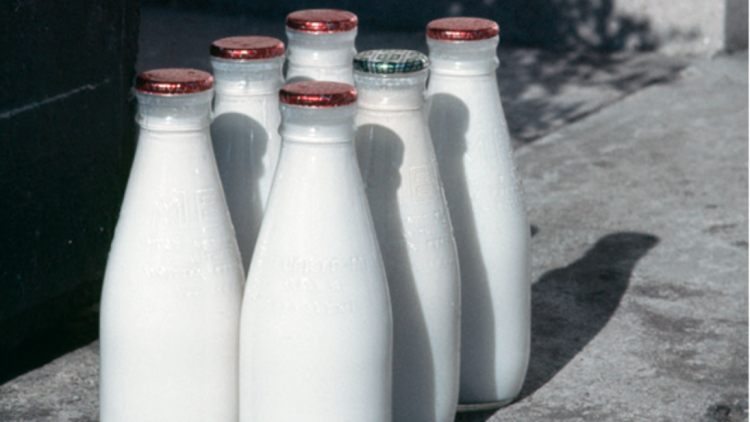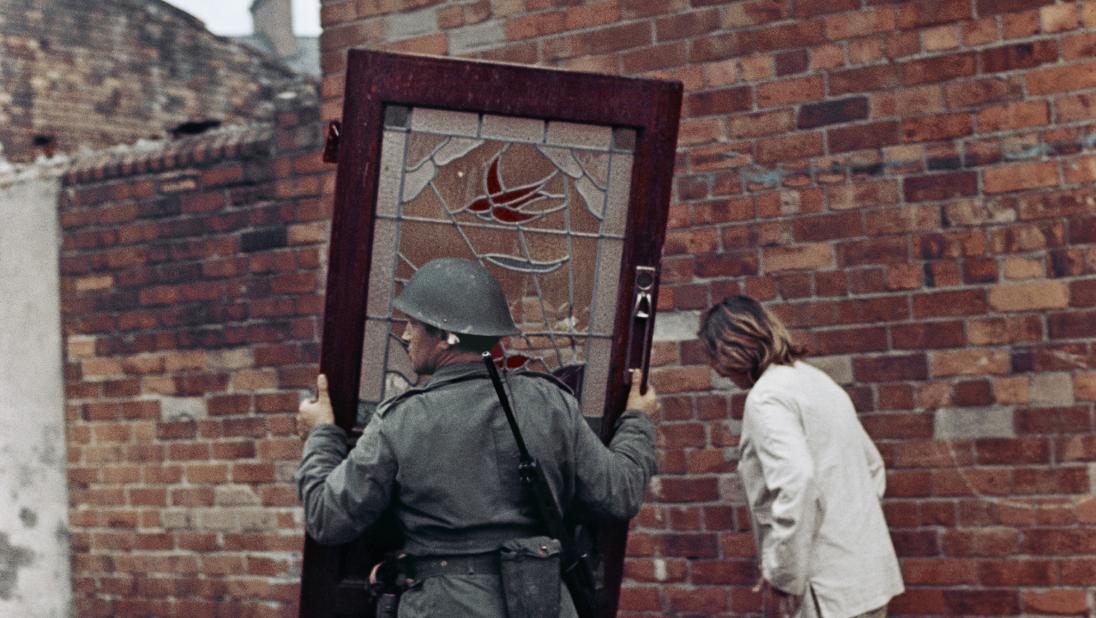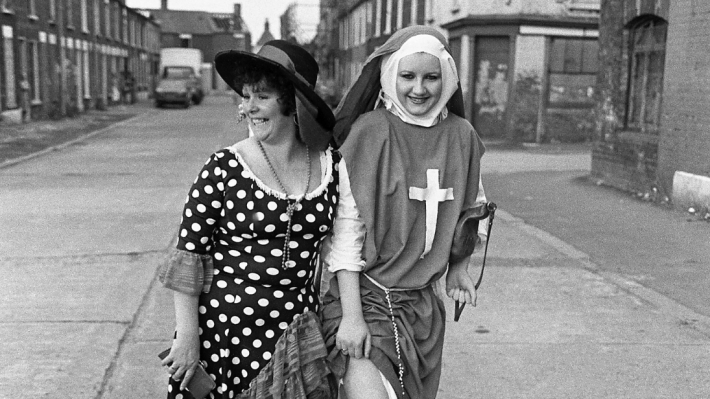
side by side: ulster museum explores the troubles through three powerful exhibitions
Akihiko Okamura: The Memories of Others joins Belfast Archive Project and The Troubles and Beyond exhibits, making it a trio of exhibitions on at once, in the Ulster Museum, to highlight the importance of museums in post-conflict Northern Ireland.
This June, Ulster Museum marked a significant moment in post-conflict storytelling with the debut of Akihiko Okamura: The Memories of Others in Belfast - a new exhibition that completes a compelling trio of Troubles-related exhibitions now running side by side in the museum.
On loan from Photo Museum Ireland, the exhibition forms a powerful showcase that reflects on the conflict through the lens of photography - capturing its complexities, aftermath and enduring human stories – and together with the long-standing ‘The Troubles and Beyond’ exhibition and a current display with Belfast Archive Project, will create experiences that connect past and present in deeply visual and emotional ways
Akihiko Okamura: The Memories of Others features rarely seen photographs by the Japanese photographer, who documented the Troubles in Northern Ireland during the late 1960s and 70s. Okamura’s images offer an outsider’s perspective on a turbulent society, focusing on everyday life rather than the conventional journalistic depictions of violence - a visual counterpoint to more sensationalist representations of the period.
After covering the Vietnam War, Okamura arrived in Ireland in 1968 and quickly developed an extraordinary, deeply personal connection to Ireland and its people. Settling in Wicklow with his family, Okamura spent the remainder of his life photographing both the North and South of Ireland. His photographs - poetic, quiet and largely in colour - present an outsider-insider perspective on the early years of the Troubles, countering the stark, black-and-white photojournalism of the time.
The exhibition is a Photo Museum Ireland touring exhibition, where it premiered in 2024 along with the short documentary and the launch of the award-winning book of the same title, all the result of a year-long digitisation of Okamura’s Irish archive undertaken under the direction of curatorial advisor to the Estate, Masako Toda and collection manager Brendan Maher. This display in Ulster Museum marks the first time Okamura’s work will be shown in Northern Ireland, coinciding with Belfast Photo Festival.
Trish Lambe, CEO of Photo Museum Ireland said "they are delighted to partner with Ulster Museum to bring ‘The Memories of Others’ to audiences in Belfast, a city that features prominently in Okamura’s remarkable Irish work."
“The exhibition, photobook (published by Atelier EXB) and documentary film (produced by Lucky Tiger Productions), are the outcome of a two-year archive digitisation project led by Photo Museum Ireland, working closely with the family of Akihiko Okamura and guided by photo historian Masako Toda.
“Initiated by curator and historian Pauline Vermare (Phillip and Edith Leonian Curator of Photography, Brooklyn Museum), the project brought together an international team of photography experts including Trish Lambe (Photo Museum Ireland), Marc Lesser (Lucky Tiger Productions), Jordan Alves (Atelier EXB), Seán O’Hagan (writer on photography), and archivist Brendan Maher. Okamura’s daughter, Kusi Okamura, also contributed a deeply moving text to the book.
“It’s a privilege to continue sharing this significant body of work with new audiences in Northern Ireland and to collaborate with the brilliant team at Ulster Museum.”
It is so significant to bring this important exhibition and largely unknown artist to the Ulster Museum, as from our past experiences of Troubles art related exhibitions, we know that displaying these artistic interpretations of the conflict can help individuals and communities reflect on what they went through at the time. Okamura’s images are extraordinary as they unobtrusively show a somewhat different Northern Ireland than what was being broadcast by the media across the world. Capturing the everyday through the lens of his camera.
Kim Mawhinney
Senior Curator of Art
While Okamura’s photography brings the outsider perspective, a second exhibition, in partnership with the Belfast Archive Project, spotlights local photographers exploring the stories behind pivotal moments in Northern Ireland’s past. Co-curated by Frankie Quinn, Belfast Archive Project’s director and the second featured artist in the three-part exhibition run, the showcase shapes a compelling narrative through the work of three local legends: Bill Kirk, Frankie Quinn and James Bell. Supported by The National Lottery Heritage Fund, the Belfast Archive Project is vital in preserving the island’s photographic heritage.
Explaining how photography can be a powerful medium for engaging with challenging themes, Frankie said,
“The works that people will experience as part of this series are each profound in their own way, depicting moments, experiences, and feelings. I hope visitors will leave with a greater appreciation for the medium of photography, recognising how it can transcend language barriers to communicate emotions, stories, and perspectives in a single instant.”


All three exhibitions showing side by side and collectively telling the story of the Troubles “will create experiences that connect past and present in deeply visual and emotional ways”, says Karen Logan, Senior Curator of History at National Museums NI.
A constantly evolving space, central to ‘The Troubles and Beyond’ exhibition, is its use of photography – capturing raw, personal moments that bring the past into sharp focus. Through intimate photographs, personal memories, and everyday objects, The Troubles and Beyond reveals that the Troubles did not unfold in isolation but were deeply woven into the lived experience of ordinary people.
Karen added,
"What we get to see through these exhibitions, by collecting and sharing powerful historical photographs, alongside personal objects, we create experiences that connect past and present in deeply visual and emotional ways. These reveal untold stories, shift perspectives, and invite reflection. Through photography, our visitors are encouraged to see the Troubles through the eyes of those who lived them, sparking vital conversations and inspiring a shared vision for a more inclusive future.”
Reflecting on the exhibitions showing side-by-side, the museum’s Director of Collections, William Blair, said:
This marks a significant moment for Ulster Museum and for how we reflect on the conflict commonly referred to as ‘the Troubles’. For the first time we’re bringing together different photographic perspectives, seen through both international and local lenses in parallel exhibitions. This, combined with our own The Troubles and Beyond gallery, offers visitors an even broader, more nuanced understanding of our shared yet conflicted past. These exhibitions don’t just document history; they help us explore its emotional and personal layers. It represents an opportunity to reflect, to learn, and to engage with the complexity of our history in a way that encourages empathy and connection.
William Blair
Director of Collections

Lead image photo caption: Street memorial on Lecky Road, Derry city, 1971, marking the site where Desmond Beattie (19 years old) was shot and killed on 8 July 1971 by the British Army. Seamus Cusack (28 years old) was shot dead near this spot about twelve hours later. These men were the first people shot dead by the British Army in Derry. ©Estate of Akihiko Okamura / ©佐藤純子
The exhibitions
Akihiko Okamura: The Memories of Others
An exhibition of rarely seen artworks by Japanese war photographer Akihiko Okamura, documenting his relationship with Ireland during the Troubles. Part of Belfast Photo Festival.
Family Album: Photographs of a Belfast Community by Frankie Quinn
See Frankie Quinn's photography in the second of a series of three exhibitions, developed in partnership with Belfast Archive project.
The Troubles and Beyond
The history of Northern Ireland from the late 1960s to the present day








